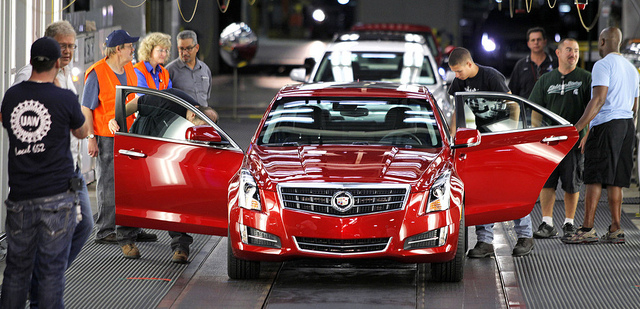Lansing and Ann Arbor staging a battle of economic might
Not long ago, the University of Michigan was undisputed king of college football in the state. But maize and blue is tattered and torn these days. Now the green and white of East Lansing’s Michigan State has bragging rights.
The battle is far more even between the Ann Arbor and Lansing economic regions.
In 2001, Ann Arbor edged out the Lansing region in economic output, with $15.95 billion to $15.83 billion for the Lansing region. It was even closer in 2013. Ann Arbor led Lansing by a sliver, with $20.42 billion in gross domestic product to $20.38 billion in Lansing, according to data by the U.S. Bureau of Economic Analysis.
But if growth trends continue, perhaps Lansing is poised to take the lead here as well after trailing Ann Arbor for 13 years.
In the Lansing region, which includes Clinton, Eaton and Ingham counties, GDP grew by 2.4 percent in 2013 over the previous year, with more growth expected from a series of recent plant investments by General Motors. But in the Ann Arbor region, which includes Washtenaw County, 2013 growth was an anemic .7 percent.
Still, by one metric, Ann Arbor is still far ahead. The Ann Arbor region churns out GDP comparable to that of Lansing with 350,000 people, compared to about 465,000 in the Lansing region. It's another way of saying the Ann Arbor region is wealthier: Its per capita income is about $58,000 compared with $44,000 in the Lansing area.
In the Lansing region, durable goods manufacturing – items like machinery, household goods and automobiles - grew by just over 10 percent over 2012, to $2.4 billion in 2013. Unlike other regions, where manufacturing still has not reached peak levels from the previous decade, that marked its peak year. Overall manufacturing, including durable and nondurable goods, is just 13.9 percent of the overall economy, well below the state average of 19 percent.
The information sector, which includes the publishing industry and telecommunications, also saw a nearly 10 percent increase in 2013 to $587 million, a 27 percent increase from 2007.
Sandra Gower, Ingham County economic development coordinator, expects manufacturing and insurance to drive future growth.
“Manufacturing is extremely important in our region. General Motors has upped its production quite a bit in Lansing and in Delta Township,” Gower said. “Going forward, we have a large insurance sector with headquarters for a number of insurance companies and we expect to see continued growth there.”
In Ann Arbor, company management grew by about 15 percent in 2013, though it’s a fifth below 2007 levels and less its peak year of 2003. Utility providers saw their sector climb 8.7 percent in 2013, though still nearly a quarter below the peak in 2004. Arts, entertainment and recreation rose nearly 8 percent 2013.
Manufacturing grew by 5.6 percent, though it comprises an even small portion of the region economy at 10.3 percent.
Both regions rely heavily on government. In the Lansing region – with both state government and Michigan State University – it's nearly 20 percent of the economy. It's even higher in the Ann Arbor region, at nearly 28 percent. The presence of the University of Michigan and the Veterans Administration Ann Arbor Healthcare System – both of which are counted under “government” GDP – accounts for much of that.
Government growth fell by 2.8 percent in the Ann Arbor region and 2.7 percent in the Lansing region.
Business Watch
Covering the intersection of business and policy, and informing Michigan employers and workers on the long road back from coronavirus.
- About Business Watch
- Subscribe
- Share tips and questions with Bridge Business Editor Paula Gardner
Thanks to our Business Watch sponsors.
Support Bridge's nonprofit civic journalism. Donate today.
See what new members are saying about why they donated to Bridge Michigan:
- “In order for this information to be accurate and unbiased it must be underwritten by its readers, not by special interests.” - Larry S.
- “Not many other media sources report on the topics Bridge does.” - Susan B.
- “Your journalism is outstanding and rare these days.” - Mark S.
If you want to ensure the future of nonpartisan, nonprofit Michigan journalism, please become a member today. You, too, will be asked why you donated and maybe we'll feature your quote next time!


 The first 2013 Cadillac ATS available for retail sale is prepared to roll off the assembly line in 2012, at the General Motors Lansing Grand River Assembly Plant in Lansing. GM is injecting a boost into the Lansing area’s manufacturing sector by investing in plant production, including plans for a stamping facility at the same plant. (Photo by Flickr user That Hartford Guy; used under Creative Commons license)
The first 2013 Cadillac ATS available for retail sale is prepared to roll off the assembly line in 2012, at the General Motors Lansing Grand River Assembly Plant in Lansing. GM is injecting a boost into the Lansing area’s manufacturing sector by investing in plant production, including plans for a stamping facility at the same plant. (Photo by Flickr user That Hartford Guy; used under Creative Commons license)